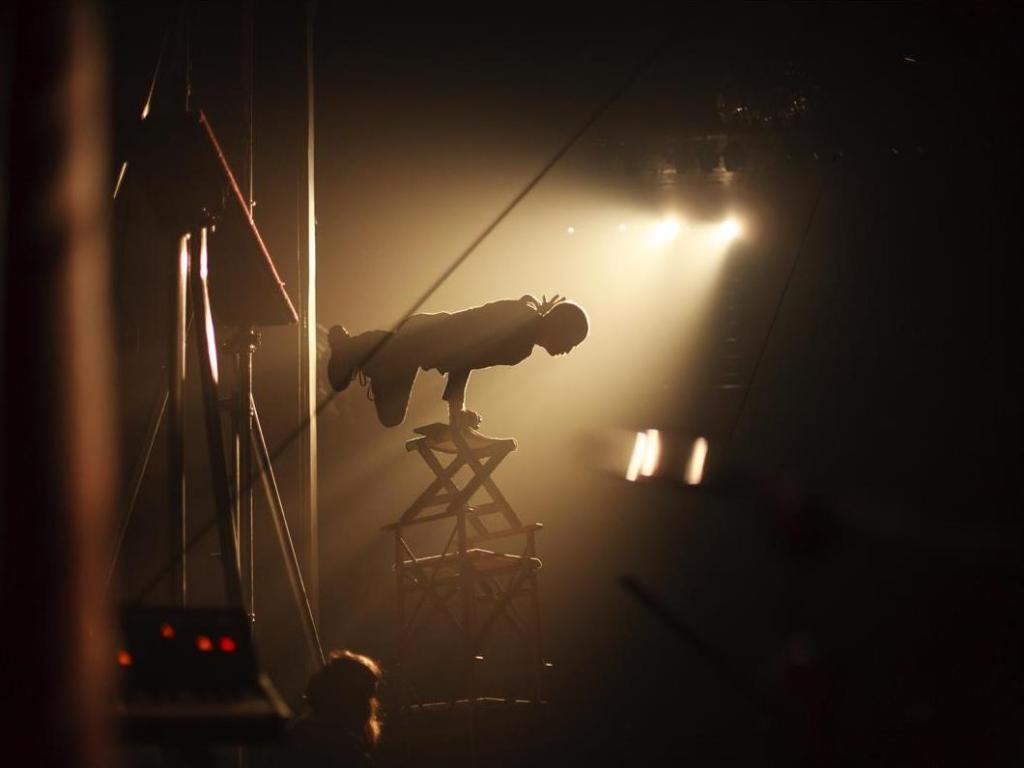Circus Oz performer Matt Wilson, photograph by Scott Hone.
Circus Oz has been touring the globe for 36 years. Our 2015 tour takes us right across North America, starting in Seattle, through the Midwest and Illinois to New Jersey and finishing with two weeks in Montreal. The challenges of taking a touring group of 20 people doing a high-level aerial, musical and acrobatic show internationally are many and varied, and over the years we’ve faced everything from natural disasters, to the unexpected deaths of Heads Of State, delayed flights, snowstorms and celebrations that took on a life of their own.
To illustrate some examples, here are some of the specific challenges we face on this current tour.
News arrives about ten days before we fly that our sea-freight has been delayed. Industrial action in the West Coast ports means the ship carrying our container is looking for a harbor. All our bulky, but crucial, equipment is now stranded at sea as the days count down. As the delay extends and the E.T.A. of our gear extends into days, then weeks, our Production team calmly goes into the process of replicating, hiring and sourcing replacements for everything in that container. At this point I like to sing the Mission Impossible theme to myself in my head to turn the feeling of impending doom into an action sequence. A new backdrop is hired in Melbourne, truss is hired in Seattle. Contacts are activated with our friends at circus schools and independent companies across America to beg, borrow or hire a full set of very specific crash mats for our Flying Trapeze act. Offers to help come in from all over, but in the end we devise a vacuum-packed system to shrink-roll our spare set of mats and squeeze them into our air-freight.
There is, to quite a large extent, an international community of contemporary circus/sideshow/cabaret culture, of which Circus Oz is one of the very first exponents of the re-invention. In North America, along with the Pickle Family Circus in San Francisco, and the Big Apple Circus in New York, many of the second and third generation companies both small and large share a migratory pool of performers and crew who have only one or two degrees of separation. In Seattle, for example, our season overlaps with one of Cirque Du Soleil’s touring shows, as well as the opening week of a new version of Teatro Zinzanni, starring Joel Salom, an Oz alumni. Zinzanni and the local circus school help us source replacement gear. With the advent of Facebook we can now put a shout-out to friends-of-friends and nearly always someone knows someone who can help.
Meanwhile final runs of the show continue. Tweaks and changes to the show, adding and editing, taking it from an Australian regional touring version to a version that will play to American audiences: generous, enthusiastic and Aussie-accent-loving, but who sometimes struggle with our fast laconic speech patterns, so we tweak and simplify.
We have always made a big effort to translate the spoken parts of the show into the local language wherever we play. Sometimes that’s very specific and sometimes political, for example using Catalan in Barcelona or Quebecois in Montreal. It’s rare that we have a native speaker in the cast, so each performer finds their own way to be understood, from learning phonetically, to sticking notes onto their props, to writing on various exposed flesh. There’s always a positive response to our language efforts, always really appreciating but also big laughs at the expense of our sometimes ridiculous pronunciation. For this tour, which includes two weeks at La Tohu, Montreal’s purpose-built circus venue, we have already started the process of translating into Quebecois. We’ve also printed a complete parallel set of placards in French, and even the extended discussion of how to translate various slogans and jokes has been an ongoing intriguing online cultural exchange.
Although this particular show has been running for over six months now, any Circus Oz show is in a constant state of evolution. Our ensemble are all creative artists in their own right, and we tour a Show Director, Debra Batton, who is tweaking, evolving and shaping the show as it goes, along with our Musical Director, the prolific Ania Reynolds, who, along with Ben Hendry, is constantly developing the musicality of the entire ensemble, and adapting and improving the score.
Because our ensemble are all individuals and we don’t use understudies or swing performers, and everyone plays one instrument or another, we are much more like a 14-piece rock band than a slick Broadway musical. Each character/performer forms part of a woven ‘score’ and each is an ingredient in the mix. As ideas develop and relationships form onstage and off, the show changes flavour and tone. By the time we tour the show internationally it has been on the road for three months of Australian regional touring, and we take pride in knowing that what the American audiences see is the direct result of Australian performers responding to Australian audiences. In terms of cultural diversity we like the idea that international audiences see a show that, in all it’s ratbaggery and eclectic eccentricity, could only have been cooked in Australia.
At any point a live show is only as good as its last performance, and a circus show is always positioned to have added a certain amount of danger to that equation, but because a small group of committed, skilled people all do their best, the show goes on!
www.circusoz.com




